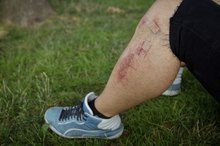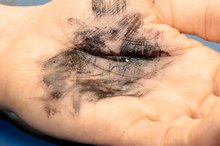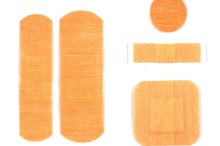What does fact checked mean?
At Healthfully, we strive to deliver objective content that is accurate and up-to-date. Our team periodically reviews articles in order to ensure content quality. The sources cited below consist of evidence from peer-reviewed journals, prominent medical organizations, academic associations, and government data.
The information contained on this site is for informational purposes only, and should not be used as a substitute for the advice of a professional health care provider. Please check with the appropriate physician regarding health questions and concerns. Although we strive to deliver accurate and up-to-date information, no guarantee to that effect is made.
Using Antiseptics in Acute Wounds
You’ve cut your hand or your child has scraped her knee. These are acute wounds.
If you are experiencing serious medical symptoms, seek emergency treatment immediately.
Whenever possible, they should be cleaned and treated immediately with an antiseptic to prevent infection.
The textbook Pharmacology for Nursing Care includes information about many of the common skin antiseptics 1. However, if the wound shows signs of infection, please get medical attention right away.
Soap
All soap cleans, but antibacterial soap is a mild antiseptic as well as a cleaner. Wash your own hands first. Then wash the entire area of the injury to prevent nearby skin bacteria from contaminating the wound.
Rinse liberally with clean water or 0.9 percent sterile saline solution, which is easier on the damaged skin. Always keep a wound clean until you can cover it properly.
- All soap cleans, but antibacterial soap is a mild antiseptic as well as a cleaner.
- Rinse liberally with clean water or 0.9 percent sterile saline solution, which is easier on the damaged skin.
Alcohol
Anti-Bacteria Solutions That Can Be Used With a Waterpik
Learn More
Alcohol is a good antiseptic, but damaging to tissues.
A 70 percent isopropyl or ethyl alcohol solution will kill germs and is ideal for cleaning around a wound. It will sting if it gets in the wound. Hand sanitizer gels, sprays or wipes may be used in this way also.
- Alcohol is a good antiseptic, but damaging to tissues.
- A 70 percent isopropyl or ethyl alcohol solution will kill germs and is ideal for cleaning around a wound.
Witch Hazel
Witch hazel has some alcohol content, but not enough to be considered a true antiseptic.
It does clean the skin, and according to the Professional's Handbook of Complementary & Alternative Medicines, it helps to stop bleeding and reduce swelling 2. It can be applied with a cotton ball that remains on the skin as a compress, if desired.
Hydrogen Peroxide
Neosporin for Scar Removal
Learn More
Hydrogen peroxide actually damages tissues and retards healing. It is no longer considered a skin antiseptic, but can be used to help remove debris from deep or dirty wounds. Wash deep or dirty wounds with soap and flush well with water or sterile saline if available.
Use peroxide if clean water isn’t available. Follow-up with an antiseptic.
- Hydrogen peroxide actually damages tissues and retards healing.
- Use peroxide if clean water isn’t available.
Benzethonium chloride
Benzethonium chloride is sold under several trade names, including salanine, BZT and diapp. It has been shown to be effective against Staph bacteria, including methicillin-resistant Staphylococcus aureus, or MRSA. The FDA indicates that benzethonium chloride should be used in limited amounts and is not recommended for antibacterial soaps and body washes.
Benzalkonium chloride
Benzalkonium chloride wipes may be in your first aid kit.
It is the safest product to use around the eyes, but should not be allowed to get in the eyes. There is a risk of becoming allergic to it with prolonged use.
Povidone iodine
Povidone iodine is a safe and effective antiseptic for almost everyone, but should not be used if there is an allergy to iodine or seafood. It is painted on with a cotton swab or a pre-soaked pad.
It is available at drugstores in liquid form as well as swabs or pads. Povidone iodine does tint the skin and can stain fabric.
- Povidone iodine is a safe and effective antiseptic for almost everyone, but should not be used if there is an allergy to iodine or seafood.
Chlorhexidine gluconate
Chlorhexidine gluconate is considered a safe and highly effective skin antiseptic. It must not be allowed to enter the ears as it can damage hearing. It can otherwise be applied liberally to the wound and surrounding area and allowed to dry on the skin.
It has a residual antibacterial action, so new bacteria will not grow in or around the wound for up to six hours. This product is available in several brands and forms at all pharmacies.
- Chlorhexidine gluconate is considered a safe and highly effective skin antiseptic.
- It has a residual antibacterial action, so new bacteria will not grow in or around the wound for up to six hours.
Related Articles
References
- “Pharmacology for Nursing Care , 5th Edition”; Richard A. Lehne PhD.; 2004
- “Professional's Handbook of Complementary & Alternative Medicines” (3rd Edition)”; Fetrow, C.W. , PharmD, Avila, Juan R., PharmD; 2004
Writer Bio
Annie Summers began writing educational materials in 1975. She covers medical topics for various websites and authors public health materials. Summers is registered and certified as a medical/surgical assistant and EKG technician. She is also licensed as a pharmacy technician.








